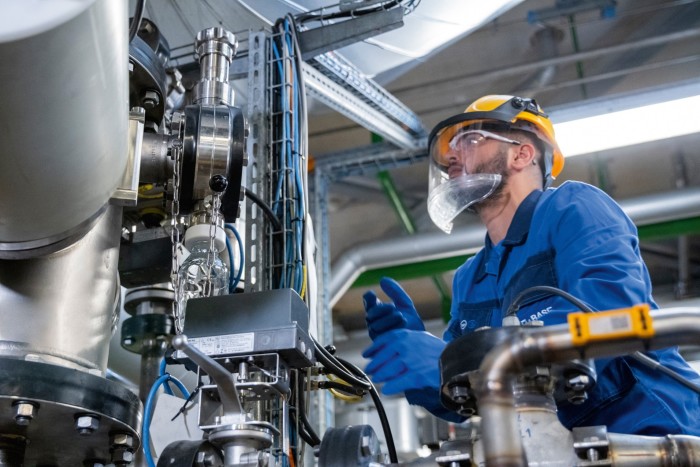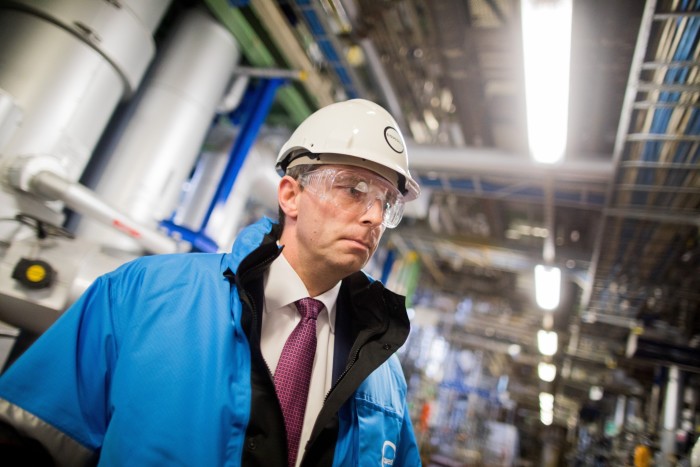
Hives of activity don’t get bigger — and busier — than BASF’s headquarters in Ludwigshafen. The size of a small town, it’s the largest integrated chemical complex in the world, with one of Europe’s biggest wastewater treatment plants, its own hospital and fire brigade.
The lifeblood of Ludwigshafen is natural gas. It is the substance that courses through its dense network of pipes, the fuel for its power plants, the feedstock for its chemical processes. And Russia’s war in Ukraine has knocked out its main supplier.
BASF first responded to the soaring price of gas by shutting down its ammonia plant and reducing the run rate of its acetylene facility, hobbling production of two chemical building blocks used to make a host of different products that are vital to modern industrial value chains.
“High natural gas prices have created a situation where importing ammonia from overseas was cheaper than manufacturing it ourselves,” says Uwe Liebelt, head of BASF’s European sites.
By October, the company had gone much further, concluding that higher energy costs had so badly undermined Europe’s competitiveness that it would have to transform its entire business.
Chief executive Martin Brudermüller announced that BASF would downsize in Europe “as quickly as possible, and also permanently”. Most of the cuts are expected to be made at the Ludwigshafen site.

BASF is not alone. Since the summer, companies across Germany have been scrambling to adjust to the near disappearance of Russian gas. They have dimmed the lights, switched to oil — and, as a last resort, cut production. Some are even thinking about moving operations to countries where energy is cheaper.
That is triggering deep concern about the future of German industry and the sustainability of the country’s business model, which has long been predicated on the cheap energy guaranteed by a plentiful supply of Russian gas.
Constanze Stelzenmüller, director of the Center on the US and Europe at the Brookings Institution, has said Germany is a case study of a western state that made a “strategic bet” on globalisation and interdependence — and was now suffering the consequences.
“It outsourced its security to the US, its export-led growth to China, and its energy needs to Russia,” she wrote in June. “It is now finding itself excruciatingly vulnerable in an early 21st century characterised by great power competition and an increasing weaponisation of interdependence by allies and adversaries alike.”
In many ways, BASF epitomises Stelzenmüller’s point. Over the years, it became highly dependent on piped Russian gas: Brudermüller said in April that it formed the “basis for our industry’s competitiveness”.
And it has become increasingly intertwined with China, which now accounts for €12bn of its annual revenues. BASF is currently building a €10bn chemical complex in Guangdong, south-eastern China, which is the largest foreign investment in its history.
Some in Berlin eye the new China plant with suspicion. “They’re basically building another version of Ludwigshafen there,” says one German official. “The fear is they might one day shut down the German site altogether and transact all their business in the Chinese factory instead. Their shareholders couldn’t care less, as long as the money keeps flowing.”
BASF has largely dismissed concerns that it’s repeating the same mistakes German business made in Russia — becoming too dependent on an authoritarian state with potentially aggressive intentions towards its neighbours. Brudermüller, who spent ten years living in Hong Kong, says BASF can’t afford not to be in China, which accounts for 50 per cent of the global chemicals market and is growing much more strongly than Europe.
There were risks, Brudermüller told reporters in October, but “we’ve come to the conclusion that China is an opportunity . . . and it makes sense to expand our position [there].” Germans should “stop this China-bashing and look at ourselves a bit more self-critically”.
Some Germans are doing just that — and calling for a major rethink of the country’s economic paradigm, on everything from deregulation to immigration. “The German business model has to change,” Christian Lindner, the country’s finance minister, tells the Financial Times. “It was based on low energy prices . . . on an abundance of skilled workers, and open markets for Germany’s high-tech products.” But “this model doesn’t really work any more because many of the core elements have changed.”
‘We’re living hand to mouth’
Meanwhile, companies across Germany are finding themselves burdened by exorbitant short-term energy costs. KPM, one of Europe’s oldest porcelain producers, founded by King Frederick the Great of Prussia in 1763, fires its vases, cups and plates in kilns that are heated to 1,600C and has no alternative to gas.
“It’s the company’s biggest crisis since the second world war,” says chief executive Jörg Woltmann. “We’re living hand to mouth.”
KPM has been able to cut its energy use by 10-15 per cent, he says, by switching off the lights and heating at weekends and packing its kilns more tightly “so we can do with one less fire”. The company has not reduced production: but its costs have soared, not just for energy but for all its raw materials and inputs like packaging. Woltmann says KPM will have to start raising prices for its products by the middle of next year.
Government statistics released last month said production in energy intensive industries, which account for 23 per cent of all industrial jobs in Germany, had declined by 10 per cent since the start of the year. Sectors like metals, glass, ceramics, paper and textiles have taken the biggest hit. “That means there are 1.5mn workers in Germany whose industries are currently under pressure,” says Clemens Fuest, head of the Ifo Institute.
Heinz-Glas, a 400-year-old glass manufacturer based in the southern state of Bavaria which makes bottles and jars for the perfume and cosmetics industry, is also suffering.

“In 2019 we paid about €11mn for energy — this year it will be €32mn,” says Carletta Heinz, the company’s chief executive.
Unlike KPM, Heinz-Glas has struggled to curb its gas consumption. “There’s little scope for energy efficiency measures,” says Heinz. “We’ve always been very careful about our energy use and so we can’t do much more to reduce it.”
Her hope is that the government will intervene to help. There are precedents: Heinz-Glas suffered a crisis in the 19th century when the price of wood, its main energy source, went through the roof. “The government financed the construction of a railway so coal could be delivered straight to our factory, and we were able to switch,” she says.
Some help is already on its way. In September, chancellor Olaf Scholz announced the creation of a €200bn “protective shield” to cushion the impact of higher energy costs on companies and households, including a “brake” on the price of gas. Heinz hopes this is just the start. “The government will do what’s needed to keep industry in Germany alive,” she says. “Because without industry our country is worth nothing.”
Germany’s glass and ceramics manufacturers may be struggling — but they are relatively small. Not so the chemical industry, which employs more than 450,000 people in Germany. “If it were to halve in size that would have a direct impact on the country’s prosperity,” says Henrik Ahlers, country manager for EY Germany.

Germany has Europe’s largest chemicals industry by far — yet it is almost entirely reliant on imported energy and raw materials. For decades, BASF, Europe’s largest industrial consumer of gas, derived most of those imports from Russia.
Now the cost of that dependence is becoming clear. The company says it had to pay €2.2bn more for gas between January and September than it did in the same period of 2021 and ended up making a €130mn loss in its German business in the third quarter. It now plans to shave €1bn in costs over the next two years, partly in response to the surge in energy prices.
BASF’s Liebelt sees little relief ahead. “The gas price has come down but it’s not even close to what it was before,” he says. “[And] it will stay significantly above what we have in the US, for example.”
The spectre of deindustrialisation
The concern now is that industrial production could, in the long term, shift away from Germany altogether. A poll over the summer by the BDI, Germany’s main business lobby, found that nearly one in four Mittelstand companies — the small and medium-sized enterprises that form the backbone of the German economy — were considering moving production abroad. It was principally energy costs that were triggering the shift.
But they’re not the only factor. The business environment in Germany — and Europe more broadly — has “deteriorated”, BASF’s Brudermüller said in October. Growth in the European market has been sluggish for a decade. EU regulation is creating “great uncertainty”, he said.
Industry leaders cite measures such as the EU’s industrial emissions directive and its chemicals strategy for sustainability, designed to ban the most harmful chemicals in consumer products.
“The regulatory burden that’s building up might be manageable for global players but I don’t know how a midsized company of 100-200 people is supposed to digest it,” says Liebelt.
The investment climate elsewhere is beginning to look more attractive. The Biden administration’s Inflation Reduction Act (IRA), which includes $369bn of subsidies for green technologies, has the potential to seduce dozens of German businesses away from their domestic base.
Under the IRA, subsidies for purchases of electric vehicles would be restricted to those made with parts from North America and assembled there, a regime the EU says would damage Europe’s industrial base and breach World Trade Organization rules.
Speaking on a recent TV talk show, Siegfried Russwurm, head of the BDI, said he was struck by “how many Mittelstand companies are saying that with . . . the advantages I have in the US with ‘Buy American’ I should seriously consider making my next investment [there] rather than in Germany”.
Some are going so far as to predict that Germany will become denuded of its industrial base. A recent note by Deutsche Bank analyst Eric Heymann predicted the share of manufacturing in Germany’s gross value added — 20 per cent in 2021 — will decline in the coming years.
“If we look back at the current energy crisis in about ten years, we could see this time as the starting point for an accelerated deindustrialisation of Germany,” he wrote.
Big multinationals will survive. But “it’s going to be a bigger challenge for the German Mittelstand, especially in energy intensive industries, to adjust to the new energy world,” he went on. “Many companies will fail to do so.”
Building on strengths
The government is less pessimistic. Robert Habeck, economy minister, told a conference in November that some were taking an “almost sensual pleasure” in predicting Germany’s decline, defining problems “just so they can wallow in them”.
“Whoever thinks we’ll let Germany as an industrial power go bust hasn’t reckoned . . . with the ingenuity of German industry, and hasn’t reckoned with the resolve of the German government and of my ministry,” he said. “It won’t happen.”
Some economists share his optimism. Jens Südekum, professor of international economics at Düsseldorf’s Heinrich Heine University, points to the government measures such as the gas price brake. “With that, the risk of deindustrialisation has been more or less eliminated,” he says.
He also stresses the long-term strengths of German industry — deep value chains, high productivity and product quality, and Mittelstand companies that are global leaders in their field.
Germany’s industrial success “is the result of long-term investments, deep knowhow and a high degree of automation”, he says. “These are advantages that have built up over decades and aren’t going to suddenly disappear.”

Germany has also shown in the past that it can successfully change its business model when its back is to the wall. “Agenda 2010”, the sweeping liberalisation of the social security system and labour market pushed through by chancellor Gerhard Schröder in 2003, is the prime example. The reforms were credited with encouraging tens of thousands back into work and reducing long-term unemployment.
“We succeeded then in sorting ourselves,” says Ahlers. “It wasn’t easy, but when you really go for it, you can get things done.”
Many in Berlin say the current crisis could provide just the same spur to reform as the high unemployment and economic stagnation of the early 2000s which led to Agenda 2010.
But it will take work, Lindner acknowledges. “We have to reform immigration to allow more skilled workers into Germany, speed up planning procedures so infrastructure projects can move forward faster, unchain our capital markets so they can finance start-ups . . . and digitise our economy and public administration,” he says.
“We have to pick up the pace and work on overcoming our weaknesses.”
However, ministers, company bosses and economists all agree that the future of German industry may hinge on how quickly it can find new ways to power itself. The country has made valiant efforts to find alternatives to Russian energy imports, building import terminals for liquefied natural gas, bringing its mothballed coal-fired power stations back online and extending the life of its nuclear reactors.

It is also speeding up the rollout of wind and solar power, a key part of its plan to derive 80 per cent of its electricity from renewables by 2030 — up from 50 per cent now — and go carbon neutral by 2045.
But BASF worries that the renewables push is happening far too slowly. “If we want to achieve our 2030 target for wind and solar, we’ll have to build almost 30 gigawatts every single year, but in the past few years we’ve built just 6.5GW on average every year,” says Lars Kissau, head of BASF’s Net Zero Accelerator. “So every year the gap grows.”
The scale of the challenge is indeed gargantuan. The wind industry says Germany must put up 6 wind turbines a day to meet the 2030 goal, requiring as much as 3,300 tonnes of steel per day — or nearly half an Eiffel Tower. Yet between January and June of this year, it managed a rate of less than one turbine a day.
Markus Steilemann, head of the VCI, the German chemicals trade body, says that faced with such hurdles, Germany risks “turning from an industrial country into an industrial museum”.
Asked about Steilemann’s comments, Habeck, the economy minister, tells the FT the situation the chemicals industry finds itself in is “undeniably challenging”. But he implies it only has itself to blame.
“They didn’t diversify their energy supply but relied on Russian gas,” he says. “And that has now turned out to have been a mistake.”







